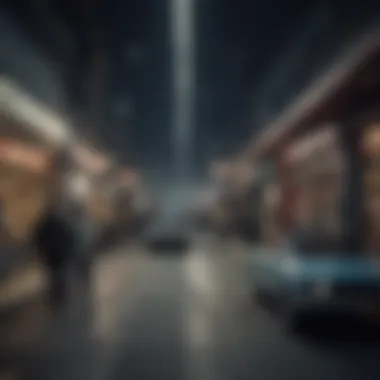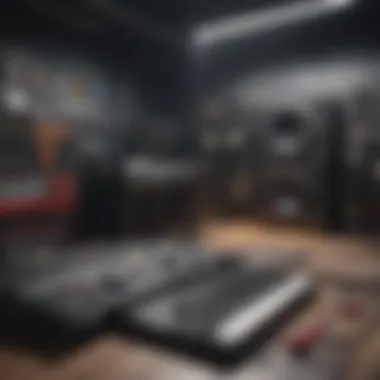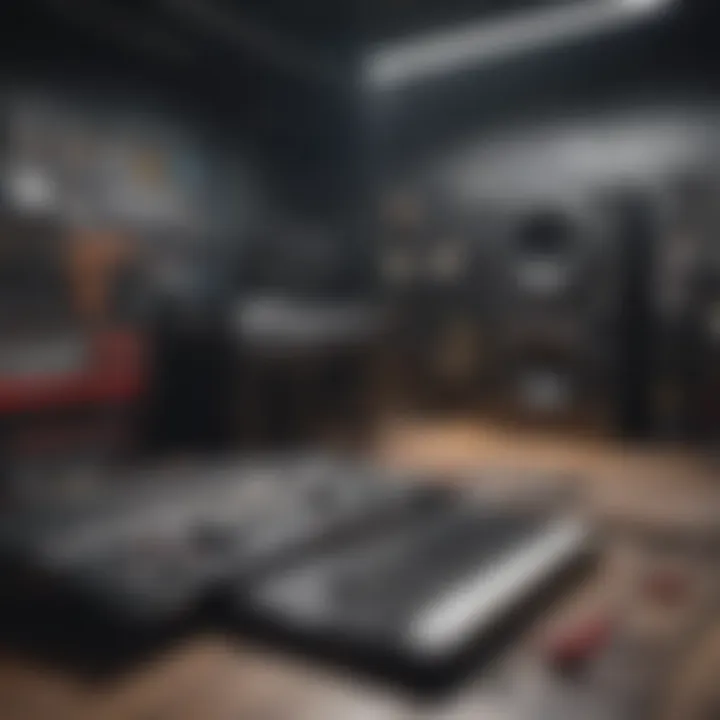Understanding Garagelogic: A Critical Exploration


Intro
Garagelogic represents a paradigm shift in discourse, particularly within the realms of music and cultural critique. This concept calls for a direct and often unfiltered evaluation of various artistic expressions, urging listeners and creators to engage with content in a candid manner. By dissecting both the mechanics of music and the cultural narratives behind it, Garagelogic aspires to foster a richer understanding for its audience. Understanding the implications of this perspective becomes essential in today’s rapidly evolving music landscape.
Artist Profile
Biography and Background
To explore Garagelogic effectively, it is crucial to appreciate the figures who embody this ethos. An example could be the artist Pavement, who epitomizes the raw and unpolished style central to this philosophy. Hailing from Stockton, California, the band formed in 1989 and carved a niche within the indie rock scene. Their music exhibits a playful disregard for conventional structures, which resonates with the principles of Garagelogic.
Major Influences and Inspirations
Pavement’s sound was significantly shaped by a blend of influences:
- Lo-fi artists, such as The Velvet Underground and The Modern Lovers, who prompted a break from polished production.
- Post-punk bands like Sonic Youth, which encouraged a more experimental approach.
- A varying panorama of cultural references, reinforcing the candid and often fragmented nature of their work.
These inspirations fostered a cultural critique that paved the way for subsequent indie musicians whose works align with the candid exploration characteristic of Garagelogic.
Song Analysis
Theme and Lyrics Breakdown
Analyzing a quintessential song like "Cut Your Hair" reveals layers of critique surrounding the indie music scene itself. The lyrics, riddled with irony, encapsulates themes of image, authenticity, and the paradox of mainstream aspirations within a subcultural framework. Lines reflecting on the perception of success and the absurdity surrounding it resonate with many listeners, inviting them to ponder their relation to music.
Instrumentation and Composition
The instrumentation in Pavement’s work often embraces a DIY aesthetic, creating an unrefined yet compelling sound. Their use of differing tempos and unexpected shifts proves engaging. The song often features:
- Guitar riffs that alternate between melodic and discordant
- Drum patterns that feel loose and spontaneous, steering away from meticulous timing
- Vocals that oscillate between sung and spoken, further enhancing the fragmented listening experience.
This composition style enhances the candid nature of Garagelogic, allowing the audience to engage with music on a more instinctive level.
"Garagelogic champions authenticity above polished perfection; it highlights the beauty found in the unfiltered moments of artistic expression."
Prologue to Garagelogic
Understanding Garagelogic is vital for anyone interested in the intersections of music and culture. This term encapsulates an unfiltered approach to examining various cultural phenomena, particularly in the realm of music. In this section, we will delve into what Garagelogic represents and why it matters in today's society.
Garagelogic challenges the norms of interpretation and appreciation. It encourages artists and audiences alike to confront their perspectives openly. This perspective has significant implications for how music is created and consumed. It invites a deeper engagement with content, moving beyond surface-level enjoyment toward a critical analysis of artistic intentions and societal reflections.
Defining Garagelogic
At its core, Garagelogic refers to an approach that prioritizes raw expression and authenticity. It seeks to strip away pretenses, allowing genuine thoughts and feelings to emerge without filters. This unrefined take on music and culture resonates with many who crave honesty in art. The term creates a framework where simplicity is celebrated, and complexity is scrutinized.
When artists embrace Garagelogic, they often produce work that reflects their real-life experiences. This authenticity fosters a connection with the audience, making the music more relatable. Listeners are encouraged to engage with the art from a personal lens, interpreting it based on their unique perspectives.
Historical Context
To fully grasp Garagelogic, it is essential to situate it within a historical framework. The development of this concept can be traced through various cultural movements over the decades. Influences come from punk rock, DIY ethics from the 1970s, and later indie music scenes. Each of these movements contributed to a growing desire for unfiltered artistic expression.
During the 1980s and 1990s, bands like Nirvana and The Clash embraced this raw aesthetic. Their music was marked by unrefined sound and candid lyrics, which spoke directly to the struggles and feelings of their time. This laid the groundwork for the emergence of Garagelogic in contemporary discussions about music and art.
Garagelogic reflects a rebellion against polished production and mainstream expectations. As society grows increasingly interconnected, the accessibility of music enables various expressions of individuality. The historical context enriches the understanding of Garagelogic, illustrating how it evolved from a reaction to cultural norms into a significant perspective within music criticism.
"Garagelogic encourages a critical lens through which music and art can be viewed, merging personal experience with broader societal insights."
In summary, defining Garagelogic and understanding its historical development presents a structured entry into its significance. It impacts not only the methods of artistic creation but also the ways in which audiences engage with art, ultimately enriching the cultural landscape.
The Philosophy Behind Garagelogic


The philosophy underlying Garagelogic fundamentally captures the essence of unfiltered expression within artistic endeavors. It embraces a raw and unapologetic examination of artistic intent, directly resonating with creators and audiences alike. By prioritizing authenticity over polished perfection, Garagelogic promotes a dialogue around the unrefined indicators of culture, challenging conventional norms and paving the way for deeper connections in artistic expressions.
Raw Expression in Art
Raw expression in art reflects a mentality where imperfection is not just tolerated, but celebrated. Artists endeavor to channel their genuine feelings and thoughts into their work, often abandoning traditional methods or expectations in favor of spontaneity and honesty. This approach resonates strongly with the principle of Garagelogic, which posits that art should not always conform to industry standards or commercial viability.
For many artists, this pursuit of rawness can lead to unexpected results. It can create a visceral connection with the audience, who may find resonance in imperfections that echo their own experiences. Some notable examples can be seen in the works of artists like Kurt Cobain, who often showcased raw emotion through his lyrics and sound, or the visual works of Jean-Michel Basquiat, where chaotic expression often communicated deeper societal issues.
The implications for artists practicing this philosophy are significant. It inspires a sense of freedom to create without constraints and allows for exploration outside traditional frameworks. This not only enhances the emotional depth of the work but also encourages a communal approach where both artist and audience engage meaningfully.
Truth and Authenticity
At the heart of Garagelogic lies the theme of truth and authenticity. In an era where authenticity is often questioned, Garagelogic champions genuine self-expression and the quest for truth in artistic practices. Artists are encouraged to reject fabrication, promote transparency, and reflect their authentic selves in their work. This pursuit complicates the often stereotypical view that entertainment must adhere to certain standards of likability or commercial success.
Truth and authenticity drive a narrative that persuades both musicians and visual artists to dig deeper into their subject matter. As a result, this philosophy values vulnerability, creating spaces for conversation about larger societal issues. It demands that artists not only present themselves honestly but that they also encourage their audiences to reflect upon their societal constructs and personal beliefs.
For instance, consider artists like Billie Eilish who delves into themes of mental health and vulnerability in her music. Her lyrics often raise questions about self-perception, living authentically, and the societal pressure that influences personal choices. Through Garagelogic, her art illustrates the potential of music as a medium for uncovering complex human experiences, making it a powerful conduit for truth.
Garagelogic in Music Culture
Garagelogic represents an unpolished, raw view of music and its cultural significance. This perspective offers unique insights into how music reflects the society that creates it. The application of Garagelogic in music culture highlights a candid critique of various aspects of artistic expression. It allows audiences to connect more deeply with the music, recognizing the wider implications beyond mere entertainment.
In analyzing Garagelogic in music culture, several elements come to light. It challenges traditional notions of artistic quality and pushes the boundaries of genre. Garagelogic encourages experimentation, promoting a culture where artists feel free to express their authentic selves. This approach can invigorate genres, leading to innovative sounds and styles that reflect current societal issues.
Influence on Genres
The influence of Garagelogic on music genres cannot be overstated. Genres such as punk, hip-hop, and grunge have thrived on principles of authenticity and rawness. These styles initially emerged from a place of rebellion against established norms.
- Punk: The punk movement embraced DIY ethics and unfiltered expression, often critiquing political and social systems. Bands like The Sex Pistols and The Ramones did not just create music; they told their stories in a way that resonated with a generation.
- Hip-Hop: In hip-hop, the storytelling aspect is vital. Artists use their platform to address issues such as poverty, racism, and identity. This genre's rise is emblematic of Garagelogic's call for honesty, offering a voice to those often silenced.
- Grunge: Bands like Nirvana and Soundgarden brought a raw, unrefined sound to the forefront. Their music was marked by honest lyrics about disillusionment and alienation.
By dissecting how genres evolve through Garagelogic, one can see how music adapts to societal changes, reflecting collective experiences and narratives.
Artist Perspectives
Understanding the perspectives of artists who engage with Garagelogic reveals much about their motivations. Many musicians feel a disconnection from mainstream norms, driving them toward a more transparent form of expression.
Artists often express a desire to connect honestly with their audience. They believe that music should mirror life’s complexities without dilution. For example, Billie Eilish addresses issues like mental health in a direct manner, appealing to listeners who may feel the same struggles.
Many artists also see Garagelogic as a way to critique their own industries. They question what it means to 'make it' in a world that often prioritizes marketability over substance.
"Music should not be a product, but a means of understanding and reflecting our realities."
Furthermore, the emergence of platforms like SoundCloud allows emerging artists to experiment without the pressures of traditional industry standards. This environment fosters a renewed sense of creativity. By embracing Garagelogic, musicians create works that are authentic, making them relatable and impactful to listeners.
Analyzing Lyrics through Garagelogic
Analyzing lyrics through the lens of Garagelogic facilitates a deeper understanding of the relationship between music and its societal contexts. This approach emphasizes unfiltered truths, allowing both artists and listeners to engage with the content on a more personal level. By examining lyrics with Garagelogic in mind, one can uncover the often complex interplay between individual identity, culture, and artistic expression.
One significant benefit of this analysis is its potential to highlight underlying themes that may not be immediately apparent. Garagelogic promotes an exploration of lyrical content that goes beyond surface interpretations. As artists often infuse personal experiences or societal critiques within their work, analyzing these elements reveals the artist's intention and the emotional undertones that resonate with audiences.
Case Studies of Iconic Songs
To illustrate the power of Garagelogic in lyrical analysis, consider iconic songs like "Fight the Power" by Public Enemy or "Blowin' in the Wind" by Bob Dylan. In these works, the lyrics serve as a reflection of the socio-political climates of their respective eras.
- "Fight the Power" delves into themes of resistance and empowerment. The lyrics confront systemic injustices faced by marginalized communities. By analyzing them through Garagelogic, one appreciates how the raw expression encapsulates a collective struggle, making it a rallying cry for social movements.
- "Blowin' in the Wind" discusses questions of freedom and peace. Though its tone may seem mellow, a deeper lyrical interpretation taps into the era's civil rights struggles. This song embodies the Garagelogic spirit by prompting listeners to reflect critically on their societal roles and responsibilities.
Analyzing such songs highlights not only individual sentiment but also cultural narratives. Each word serves as a vehicle for significant discourse.
The Role of Interpretation
Interpretation plays a crucial role in how lyrics are understood within the Garagelogic framework. Each listener brings their own context to the table, influencing how they perceive and relate to a song's message. Thus, the interactions between personal experience and lyrical content create a rich landscape for analysis.


When listeners engage with lyrics interpretatively, they often discover multiple meanings. This multifaceted approach encourages critical thinking, pushing boundaries of conventional interpretations. By embracing various viewpoints, listeners can uncover new layers of significance, which is vital in any discussion around Garagelogic.
Furthermore, acknowledgment of diverse interpretations can foster a more inclusive understanding of music. Engaging with songs from different backgrounds or cultures allows for a dialogue that values multiple perspectives.
"The beauty of music lies in its ability to convey emotions transparently, transcending barriers and inviting varying interpretations."
Garagelogic and the Modern Listener
Garagelogic, as a concept, resonates deeply with the modern listener. In contemporary music culture, listeners are not just passive consumers; they are active participants who engage with the themes and emotions embedded in musical works. This active engagement is where Garagelogic finds its significance. It provides tools for listeners to dissect and appreciate the rawness and honesty present in today’s music landscape. As musicians explore more candid and unfiltered expressions, the audience is compelled to adapt their listening approaches and embrace a more critical perspective.
Cultural Critique
In the context of Garagelogic, cultural critique serves a pivotal role. It empowers listeners to evaluate their surrounding cultural landscape deeply. Today’s music often addresses societal issues, personal struggles, and existential dilemmas. Listeners equipped with a Garagelogic framework are better positioned to decipher messages channeled through lyrics and melodies. They recognize that art is not merely entertainment but a reflection of lived experiences and societal narratives. This awareness solidifies the bond between artist and audience, creating a dialogue that challenges traditional notions of acceptance and appreciation.
- Critical Examination: Listeners question the mainstream narratives surrounding music. This critical approach invites conversations about artistic authenticity.
- Awareness of Context: Understanding the historical and social context of songs enhances the listener’s appreciation.
- Encouragement of Diverse Voices: Garagelogic fosters a cultural environment that embraces various perspectives, promoting inclusivity in music.
"Music today is not just heard, but felt, examined, and critiqued. This is the essence of Garagelogic."
Building a Critical Mindset
In order to fully engage with Garagelogic, listeners must cultivate a critical mindset. This involves training oneself to approach music not just as entertainment but as a medium for communication and expression. Building this mindset requires practice, curiosity, and an open heart. One effective approach is to actively analyze the lyrics and themes of songs.
- Active Listening: Instead of letting melodies wash over them, listeners should consciously pay attention to lyrics and musical elements.
- Engaging with Social Issues: Understanding how songs connect to social movements fosters a more empathetic engagement.
- Discussion and Debate: Engaging in conversations with other music enthusiasts encourages different viewpoints and interpretations.
Developing a critical mindset contributes to a rich music experience. It leads to a more profound appreciation and understanding of the complexities that underlie art in any form. As listeners grapple with the messages conveyed through Garagelogic, they become more informed participants in the music culture.
The Societal Impact of Garagelogic
The concept of Garagelogic plays a transformative role in modern societal discourse, particularly through the lens of music and culture. As an unfiltered critique, it has the potential to challenge prevailing narratives, provoke thoughtful discussions, and encourage authenticity in expression. Understanding the societal impact of Garagelogic allows both artists and audiences to engage with cultural content on a deeper level, reflecting broader social movements and shifts in perspectives. This section will delve into the implications of Garagelogic, emphasizing its relevance in shaping cultural identity.
Reflections on Popular Culture
Garagelogic serves as a mirror to popular culture, allowing individuals to confront the complexities of contemporary life. It reflects the raw truths about societal norms and expectations. The straightforwardness of this approach can penetrate the facade of polished media presentations, inviting discussions that might otherwise remain unaddressed.
In recent years, as audiences demand authenticity, Garagelogic influences the Content they consume. Artists are increasingly encouraged to express their truths candidly. In turn, this unconditioned output leads to a cultural environment where vulnerability is celebrated. Such expressions often remain in stark contrast to the curated profiles prevalent on social media platforms like Facebook and Instagram.
Moreover, this raw approach fosters connections between creators and consumers. Fans appreciate when artists convey genuine experiences in their work. This relationship often cultivates a sense of community, empowering individuals to share their narratives, thereby enriching the cultural tapestry.
The Significance of Music in Society
Music acts as a powerful cultural vehicle and serves a critical role in societal reflection. Garagelogic highlights this intersection, providing insight into how music can be a form of activism and social change.
- Mobilization: Music has historically mobilized movements, echoing voices of protest and resistance. Artists employing Garagelogic can provoke change by addressing societal issues such as inequality and injustice in their lyrics, pushing listeners to examine uncomfortable truths.
- Cultural Identity: Music shapes cultural identity, often encapsulating the experiences and struggles of specific communities. Garagelogic enables artists to articulate these identities without censorship. This authenticity reinforces a shared understanding among listeners.
- Therapeutic Value: Many find solace and healing in music that resonates with their personal struggles. When artists reveal their challenges through Garagelogic, it fosters an environment of empathy and support among audiences, enhancing the social fabric.
"Music expresses that which cannot be put into words and that which cannot remain silent" - Victor Hugo.
Contemporary Examples of Garagelogic
Exploring contemporary examples of Garagelogic provides significant insights into its evolving nature. Artists today use this philosophy to challenge norms and express individuality. They offer fresh perspectives that resonate with audiences, establishing a dialogue about art and culture. Notably, this engagement reflects a balance between creativity and authenticity, shedding light on how contemporary society perceives art forms.
Emerging Artists
Emerging artists are at the forefront of the Garagelogic movement. They often start with limited resources, which fosters raw expression and experimental approaches. Their work is frequently marked by a candid portrayal of personal and social themes. For instance, many of these artists utilize platforms such as SoundCloud and Bandcamp to share their music. They bypass traditional industry norms, allowing for unfiltered communication with their audience.
Some notable emerging artists include:
- billie eilish: She gained fame by cultivating an authentic sound that defies mainstream expectations.
- Girl in Red: Known for her confessional lyrics, she speaks openly about mental health and personal struggles.
- Arlo Parks: Her poetic storytelling combines soulful melodies with poignant cultural observations.
These artists embody the Garagelogic ethos by addressing contemporary issues without the constraints typically imposed by producers or record labels.


Influential Movements
Influential movements in the realm of Garagelogic serve as reflections of broader societal currents. Genres like punk and hip-hop have roots in unfiltered expression, and their resurgence showcases a return to these principles. Take fast-paced punk bands reviving aggressive music styles while commenting on political disillusionment. Similarly, modern hip-hop artists often tackle themes of identity and inequality, bringing their lived experiences to the forefront.
Examples of influential movements include:
- DIY Punk: A grassroots approach to music production emphasizes authenticity and self-organization.
- Lo-Fi Hip-Hop: It creates a relaxed listening experience while often integrating candid lyrics that tackle real-life issues.
- Indie Pop: Merges catchy sounds with distinct, personal narratives, appealing to a diverse audience.
These movements reflect the ongoing relevance of Garagelogic in music culture. They remind us that art can be a potent mirror of society, capturing raw emotions and thoughts.
Challenges and Criticisms
The exploration of Garagelogic presents various challenges and criticisms that deserve careful consideration. Understanding the limitations and potential misinterpretations of this concept is crucial for meaningful discourse. These challenges highlight the nuanced nature of Garagelogic and its position within contemporary music and culture. The complexity of this subject makes it necessary to analyze both its positive and negative implications for artists and audiences alike.
Misinterpretations of Garagelogic
One major challenge lies in the misinterpretation of Garagelogic itself. Many enthusiasts may perceive it as merely a form of raw and unpolished expression. While authenticity is important, reducing Garagelogic to a simplistic definition ignores its deeper layers. Scholars and critics sometimes conflate honesty with a lack of craftsmanship. This misinterpretation often leads to the dismissal of works that exemplify Garagelogic as mere chaos or noise, rather than appreciating the intent behind them. Such a perspective can hinder a comprehensive understanding of artistic intent and message.
Garagelogic encourages dialogues that may be uncomfortable or challenging. Still, it is essential to acknowledge the ability of this approach to provoke thought. Misinterpreting it as simply contrarian can limit its potential as a tool for critical examination. Artists utilizing Garagelogic often aim for honesty in their work, but listeners must be careful not to misconstrue this honesty as a lack of skill or merit.
The Balance between Art and Critique
Navigating the balance between art and critique is another complex aspect of Garagelogic. While the concept values authenticity and candidness, it can also lead to a sense of hostility toward more polished forms of music. The expectation that all art must embody a rawness may alienate those who find beauty in technical prowess or lyrical finesse. As a result, artists may feel pressured to conform to the principles of Garagelogic, potentially stifling individual creativity and expression.
Moreover, critics face the challenge of evaluating works within the framework of Garagelogic. The emphasis on rawness might lead to overlooking the skill involved in creating seemingly unfiltered art. This can create tension wherein works deemed "artistic" might be unfairly categorized as trivial or lesser. It raises the question: How do we offer critique without undermining the artist's intent?
To achieve a balance, it is essential to appreciate both the artistic expression and the core messages conveyed through Garagelogic. Critics and audiences alike must approach this discourse with an open mind. Recognizing the value in varied artistic expressions can cultivate a richer dialogue, allowing Garagelogic to coexist with traditional art forms.
"The interpretation of art should not merely rest on aesthetics but engage with the deeper questions it poses to society and culture."
Future of Garagelogic
Understanding the future of Garagelogic unveils a crucial layer in our ongoing dialogue about its relevance and application. As society continues to evolve, so too will the interpretations and manifestations of Garagelogic in music and culture. This section investigates pivotal elements such as shifting perspectives, the impact of technology, and implications for artistic expression.
Evolving Perspectives
The viewpoints surrounding Garagelogic are naturally dynamic. Traditionally grounded in an unfiltered examination of music, Garagelogic has begun to expand its definition to encompass broader cultural critiques. For aspiring musicians and students, it emphasizes the importance of authenticity in their work. This authenticity is less about the perfection of sound and more about an honest expression of experiences and emotions. The evolution can also be traced to how artists perceive their roles within society. Here, a movement towards self-awareness is prominent. Artists are actively questioning their influences, inspirations, and intentions, often leading to a more conscious engagement with their audiences.
Additionally, the concept of Garagelogic challenges the status quo. As artists begin to explore their boundaries, they encourage audiences to reflect critically. The discourse becomes a two-way street, fostering a shared sense of engagement between creators and listeners. This progression indicates that Garagelogic is not merely a form of expression but a powerful tool for cultural introspection.
Garagelogic in the Digital Era
The digital age presents unique opportunities and challenges for Garagelogic. Platforms such as Bandcamp, SoundCloud, and even social media channels like Twitter provide new avenues for artists to share their work without the filters imposed by traditional record labels. This decentralization aligns with the core ethos of Garagelogic, allowing for raw and candid artistic expressions to reach a global audience.
However, this accessibility brings forth a layer of complexity. Artists must navigate an oversaturated market, where unique voices can often get lost. The challenge lies in maintaining authenticity while driving engagement in a digital landscape that often prioritizes trends over substance.
The impact of digital platforms cannot be understated; they redefine how we interact with music and culture, providing fresh avenues for Garagelogic to flourish.
As Garagelogic continues to permeate through digital means, it pushes individuals to approach music not just as consumers but as active participants in a collaborative cultural narrative. This denotes a movement toward inclusivity, where voices from varied backgrounds contribute to the ongoing conversation.
End
The conclusion of this article serves multiple purposes. Its primary aim is to synthesize the insights gained throughout the exploration of Garagelogic. In doing so, it reinforces the significance of this concept in current discussions surrounding music and culture. Understanding Garagelogic allows for a more nuanced perception of artistic expression and criticism. It is not just a fleeting topic but rather a substantial framework through which one can examine and appreciate depth in art.
Summarizing Key Insights
The discussion around Garagelogic reveals several key insights:
- Authenticity in Art: Garagelogic emphasizes the importance of authenticity within artistic expression. It challenges artists to remain true to their voice without succumbing to commercial pressures.
- Cultural Reflection: The concept acts as a mirror to society, reflecting its virtues and vices through the lens of music. There is a dual role of artist and audience in this reflection.
- Critical Engagement: Understanding Garagelogic fosters critical engagement. It encourages listeners to go beyond surface-level interpretations of music, considering context, intention, and societal implications.
Through these insights, we appreciate how Garagelogic impacts both artists and audiences alike. One's perspective can shift significantly when considering the core tenets of sincerity and critique.
Implications for Future Discourse
As we look towards the future of cultural discussion, the implications of Garagelogic are vast. It invites a reevaluation of how society engages with forms of art:
- Open Dialogue: There needs to be a push for open dialogue about artistic expression, where both the triumphs and failures are discussed candidly.
- New Movements: Emerging artists within the framework of Garagelogic have the potential to reshape genres. They can lead to the birth of new movements that emphasize raw emotion and critique.
- Digital Media: In the digital era, platforms will become an integral part of how Garagelogic evolves. Artists can now disseminate their work without traditional barriers, which could lead to a renaissance of unfiltered creativity.







